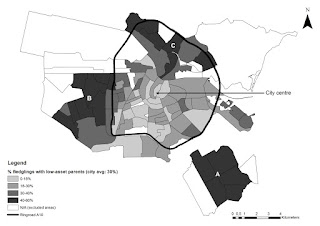Cody Hochstenbach & Willem R. Boterman
University of Amsterdam, The Netherlands
Across many different urban contexts,
young people are currently faced with increasing constraints on the housing
market. Inflating housing prices and stricter mortgage lending criteria render homeownership
out of reach for more and more young people who, increasingly dependent on
temporary employment contracts, are unable to acquire a mortgage at all.
Consequently, increasing numbers of
young people are unable to leave the parental home. Those who do manage to leave
the parental home are increasingly dependent on expensive and/or temporary
rental housing. Hence, the notion of an emerging “Generation Rent” has been gaining
traction in the UK.
It has frequently been highlighted
that parental support, in both financial and non-financial ways, may improve young
people’s housing market position. Parents may help to buy a place for their
offspring or cover (part of) their rental costs. Furthermore, they can provide
useful social networks or broker housing in other ways – giving their offspring
a head start on the housing market. Consequently, inequalities are transmitted
across generations.
The impact of the intergenerational
transmission of inequalities on neighbourhood outcomes is not often studied
however. This is an important omission in terms of understanding inequalities
in the formation of residential trajectories in relation to urban space.
In recent years the population of Amsterdam
has grown substantially, in part due to an increasing influx of students and the
retention of recent graduates. These trends, combined with the housing choices
of middle-class families already present in the city, have played a pivotal
role in the gentrification of Amsterdam’s inner ring (a process which local
authorities have been happy to accommodate and further stimulate). Simultaneously,
the outer ring areas have increasingly become sites where poverty concentrations are increasing.
In our study we have investigated the extent to which parental
support and broader class background play a role in forging young people’s neighbourhood
outcomes. We particularly focused on young people leaving the parental home – a
key moment in the life course and the gradual transition towards independence
and adulthood.
The findings are quite striking:
young people with “wealthy” parents overwhelmingly move to Amsterdam’s
inner-ring neighbourhoods (see the maps). These are predominantly either
high-status and expensive neighbourhoods (the Canal Belt and the affluent Old
South (marked with an F) being good examples), or gentrifying neighbourhoods –
including neighbourhoods of already mature gentrification like De Jordaan (G), or the hip De Pijp neighbourhood (H).
Young people from relatively poor backgrounds mainly move to the city’s outer
ring areas (A, B, and C in the maps), often post-war extensions to the city
characterized by a relatively low status. These patterns hold when controlling
for a range of personal characteristics, including income.
While the housing outcomes of young
people may be the result of financial support, they also reflect broader
processes of social reproduction involving social and cultural forms of
capital. Facilitating their children to move into inner-ring neighbourhoods –
often in relation to participation in education – is a key strategy in this
regard,– making David Harvey’s work on residential differentiation highly pertinent
to understanding processes of change affecting Amsterdam neighbourhoods.
The
choices being effected by the children of middle class families in the Amsterdam
housing market have impacted neighbourhood gentrification, and have contributed
to processes of displacement and exclusion.
Young people from middle class backgrounds – despite their typically low
incomes – are not only able to outbid other young people from poorer
backgrounds, but can also be considered the (potential) carriers of parental
wealth into previously poor (gentrifying) areas. Intergenerational wealth
transfers can allow young people to pay otherwise unaffordable rents or are
part of parental investment strategies in housing in areas where returns are
relatively high. In such ways can parental wealth effectively be put to use to
outbid other households and household types, contributing to their exclusion or
displacement and ultimately advancing the gentrification process.
Source: Hochstenbach & Boterman (2015);
own adaptation of CBS/SSB data.



No comments:
Post a Comment